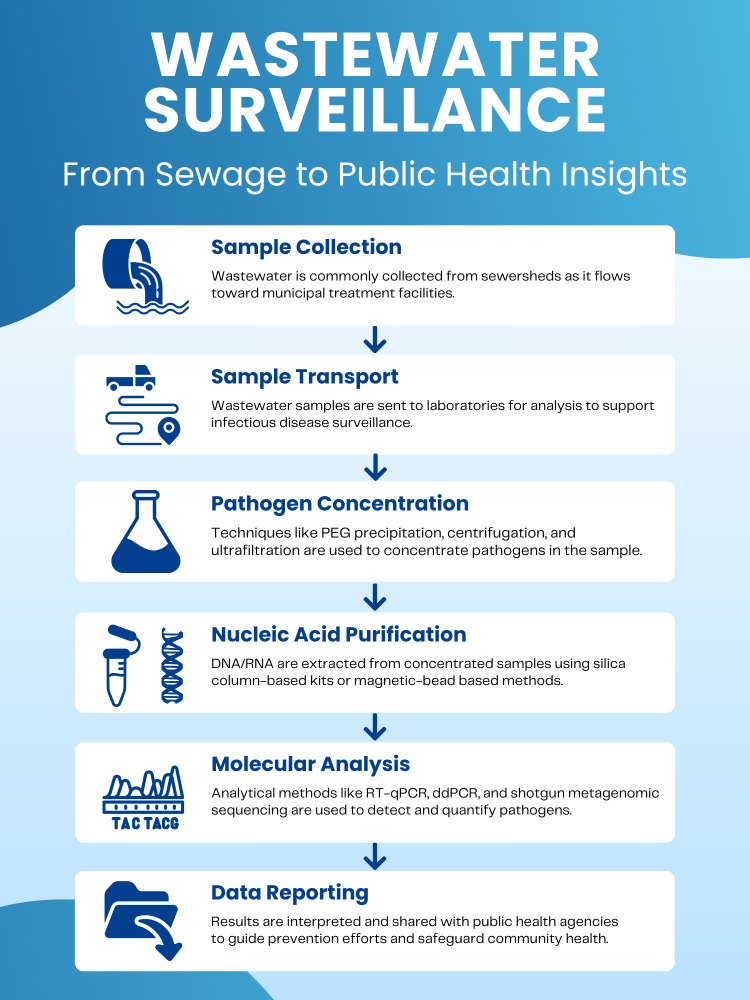In the aftermath of the COVID-19 pandemic, wastewater has emerged as a vital tool for understanding and protecting public health. Wastewater surveillance, or the monitoring of sewage for biological and chemical markers, emerged as a critical early warning system for detecting disease outbreaks and tracking antibiotic resistance across entire communities. As the world moves beyond the pandemic, a new question arises: how can we continue to harness the full potential of wastewater monitoring to safeguard public health? This blog explores how wastewater-based epidemiology is transforming the way governments, health organizations, and industries anticipate and respond to health threats, ushering in a new era of proactive, data-driven public health.
What is Wastewater Surveillance?
Every flush and drain in a community tells a story about public health. Wastewater, which includes water from household sinks, showers, toilets, industrial processes, and storm drains, carries biological and chemical substances that can reveal critical health trends. Wastewater surveillance is a powerful public health tool that analyzes these substances to track disease spread, environmental pollutants, and other key health indicators. By sampling sewage, researchers can detect pathogens such as viruses, bacteria, and fungi, as well as antimicrobial resistance genes and biomarkers related to drug use or environmental exposure. Pathogen detection relies on extracting and analyzing nucleic acids from wastewater and sludge, a complex process requiring advanced technologies.
Why is Wastewater Surveillance Important?
A key advantage of wastewater surveillance is its ability to detect infections before individuals seek medical care. Many pathogens, such as SARS-CoV-2, are shed in waste even before symptoms appear, making wastewater an early warning system for tracking outbreaks, monitoring variants, and assessing community transmission. This allows public health officials to prepare for outbreaks, implement mitigation strategies, and inform vaccination programs.
Wastewater surveillance aligns with the One Health approach, which recognizes the interconnectedness of human, animal, and environmental health, providing a comprehensive method for tracking zoonotic diseases and monitoring antimicrobial resistance across ecosystems. The COVID-19 pandemic highlighted its value as a cost-effective, anonymous, and accessible tool for public health. Unlike traditional testing, wastewater monitoring does not rely on individual healthcare access, making it useful for communities of all resource levels. Investing in advanced technologies and public health infrastructure is essential for strengthening wastewater monitoring and ensuring preparedness for future pandemics, antimicrobial resistance, and other public health threats.
How Does Wastewater Surveillance Work?
Raw wastewater from sewer sheds is the primary sample type used for wastewater surveillance. It is typically collected before treatment as it flows into treatment plants, though samples may also be taken at different stages of the treatment process depending on the study goals. These samples are then sent to public health or environmental laboratories, where they are analyzed for early signs of infectious diseases circulating in the population. In the laboratory, samples undergo processing to concentrate viruses, bacteria, and other pathogens. Common concentration methods include polyethylene glycol (PEG) precipitation, ultrafiltration, and centrifugation, which improve detection sensitivity by increasing pathogen density.
Once concentrated, nucleic acids (DNA/RNA) are extracted and purified, often using silica column-based kits or magnetic bead-based methods. Many labs employ automated extraction systems to enhance efficiency and throughput. Following nucleic acid purification, samples undergo molecular analysis. Reverse transcription quantitative PCR (RT-qPCR) remains the gold standard for detecting RNA viruses such as SARS-CoV-2 and Norovirus. Quantitative PCR (qPCR) is commonly used to detect DNA from a wide range of pathogens, including bacteria like Salmonella and Shigella. Emerging technologies like digital PCR (dPCR) and droplet digital PCR (ddPCR) offer improved quantification accuracy in low-concentration samples and greater tolerance to PCR inhibitors, making them increasingly popular in wastewater testing.
In recent years, next-generation sequencing (NGS) has emerged as a powerful complement or alternative to PCR-based methods. NGS allows for broad-spectrum detection of known and unknown pathogens in a single run. Shotgun metagenomic sequencing, in particular, provides comprehensive profiling of microbial communities, enabling identification of emerging threats without prior knowledge or targeted assays. This makes it invaluable for variant tracking and outbreak surveillance. Probe-based (hybridization-based) enrichment methods have also been developed to selectively capture viral targets, increasing sensitivity and enabling more efficient detection of low-abundance pathogens.
Other cutting-edge approaches are also on the horizon. CRISPR-based detection platforms are being explored for their speed and specificity, and biosensors are being developed to offer real-time monitoring capabilities directly at treatment sites. Once data is generated, results are interpreted and reported to public health agencies. This information helps guide preventive actions such as vaccination campaigns, travel advisories, or targeted testing, all aimed at reducing transmission and protecting community health. This integrated approach to wastewater monitoring enhances early warning systems and strengthens public health responses.

A Complete Workflow for Wastewater Surveillance
Zymo Research offers a fully integrated, end-to-end workflow for wastewater surveillance that is trusted by public health agencies, researchers, and industries around the world. The process begins with safe and efficient sample collection using the Wastewater Sample Collection Bottle, pre-filled with a proprietary stabilization buffer that inactivates pathogens and preserves nucleic acids at ambient temperature for up to seven days. In addition to preservation, the Wastewater Stabilization Buffer facilitates the efficient pelleting and capture of viral, microbial, and free nucleic acids, which eliminates the need for lengthy vacuum filtration or ultracentrifugation concentration methods.
Following collection, the Quick-DNA/RNA™ Water Kit enables high-yield extraction of inhibitor-free DNA and RNA from large-volume samples, delivering high-quality input for sensitive downstream applications such as qPCR, ddPCR, and NGS. For comprehensive analysis, Zymo Research offers in-house microbiome profiling services, combining expert molecular data generation, advanced bioinformatics, and publication-ready reporting. As a global leader in molecular tools and technologies, Zymo Research is uniquely positioned to support wastewater surveillance at every stage, helping build a healthier, more resilient world.
